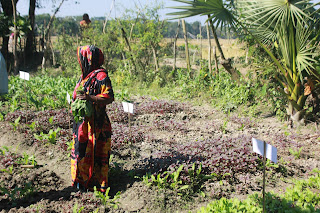Poverty in Bangladesh: Where to focus and how? [Newspaper Article]
This year’s Nobel Prize for Economics has gone to Abhijit Banerjee and Esther Duflo, both MIT professors, and Professor Michael Kremer of Harvard University, for their “experimental approach to alleviating global poverty”. Parts of their work focused on some poverty reduction programmes in Bangladesh. Coincidentally, the Royal Swedish Academy of Sciences announced the award on October 14, three days before the world marks the International Day for the Eradication of Poverty on October 17. With the UN deadline for achieving the Sustainable Development Goals only 11 years away, what is the poverty scenario in Bangladesh?
Behind this rosy picture, however, lies a sorry state: Bangladesh
is still home to around 40 million poor and 21 million extreme poor according
to 2016 data from BBS (HIES 2016). Globally, one in every eleven people are
poor, according to 2013 data released by the World Bank in 2016.
Poverty, often likened to chronic diseases, is a multi-dimensional
phenomenon. And to address the multi-dimensional aspects of poverty, any
poverty reduction programmes or projects should be context-specific, need-based
and demand-driven. Inclusive growth will remain a far cry if we do not give
special attention to lift the extreme poor living in areas with higher poverty
rate. That’s where targeting comes in, to direct the benefits of the poverty
elimination programmes to the ones who need them the most, and soonest.
Targeting is important especially because the power dynamics in our society
play a key role in the inclusion and exclusion process.
Based only on the financial aspect of poverty, the poor could be
categorised as “income poor”, i.e., lack of income, and “human poor”, i.e.,
lack of basic human capacity in terms of good education, health, sanitation,
safe water and so on. Poor could be classified as “extreme poor”, “moderate
poor” and “vulnerable non-poor” based on the depth of poverty. Many people who
are poor can get out of the poverty trap in a short period of time. However,
many a time they fall back into poverty shortly afterwards following sudden
shocks, such as ailments or natural disasters. They are “transient poor”, the
most vulnerable to poverty.
For any poverty elimination programme to be successful and
sustainable, all actors—government policymakers, development partners and implementing
organisations (NGOs)—must devise appropriate plans for their income generation,
and developing and improving their capacity to cope with this vulnerability.
One final point. The poor are a highly heterogeneous group rather
than a homogenous one. Even the ultra-poor can be highly heterogeneous—some
living in rural areas, others in urban areas. Some live in the coastal belt,
others on the hills or islands or chars. Even the first-generation ultra-poor
and the fifth-generation ultra-poor have varied characteristics and therefore
distinctive needs.
Dr AKM Nuruzzaman is a development worker, currently working at
Palli Karma-Sahayak Foundation (PKSF) as a General Manager.
Email: nuruzzamanpksf@gmail.com
Published in the Daily Star on October 18, 2019
It can be accessed
by clicking the following link.
https://www.thedailystar.net/author/akm-nuruzzaman


Comments
Post a Comment